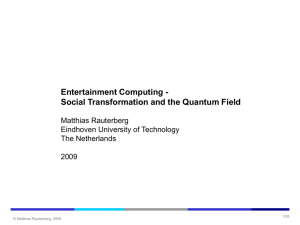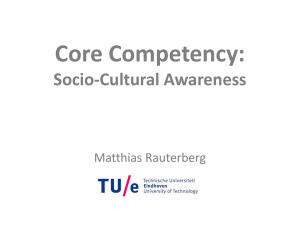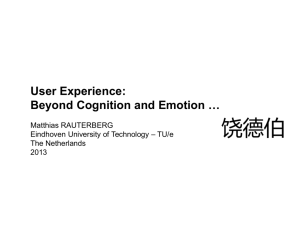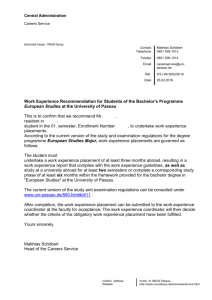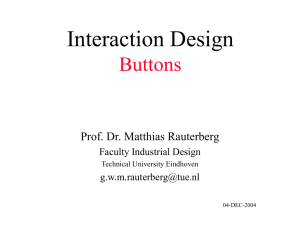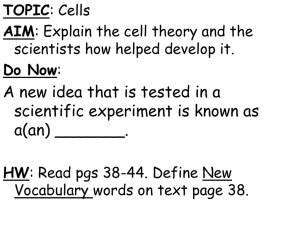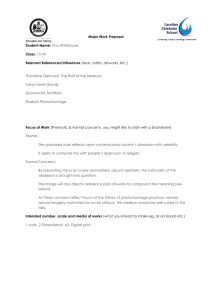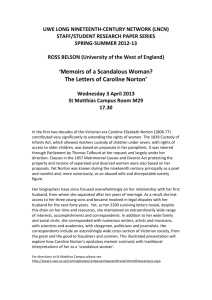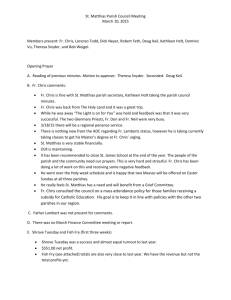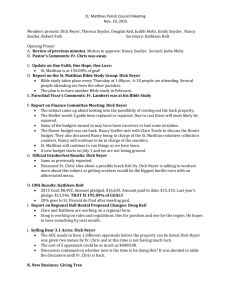PPT
advertisement
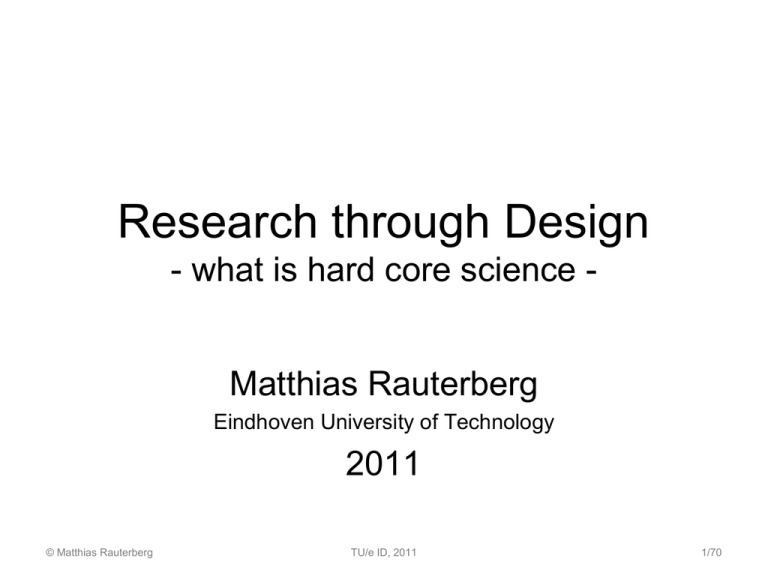
Research through Design
- what is hard core science Matthias Rauterberg
Eindhoven University of Technology
2011
© Matthias Rauterberg
TU/e ID, 2011
1/70
Thinker versus Tinker
“There is nothing so
practical as a good
theory."
"Don't worry about
what anybody else is
going to do… The best
way to predict the
future is to invent it.
Really smart people
with reasonable funding
can do just about
anything that doesn't
violate too many of
Newton's Laws!"
(1971)
Ludwig Boltzmann (1884-1906)
© Matthias Rauterberg
Alan C. Kay (1940-)
TU/e ID, 2009
2/70
How do we get theories?
theories and models
abstracting
concretisation
reality (t1)
reality (t2)
positivism :
constructionism :
{theory, model reality
{theory, model reality
reality (t1) ≈ reality (t2)
reality (t1) reality (t2)
[REFERENCE: Rauterberg M. (2006). HCI as an engineering discipline: to be or not to be!?. African Journal of Information and Communication Technology, vol. 2, no. 4, pp. 163-184]
© Matthias Rauterberg
TU/e ID, 2009
3/70
What kind of knowledge?
Theory
Test
Design
Design
Theory
Model-T
© Matthias Rauterberg
Test
Model-D
TU/e ID, 2009
4/70
Paradigm and novelty
existing
paradigm
existing
knowledge
rejected
novelty
x
accepted
novelty
x
Novel results outside the
present paradigm are
mainly rejected by the
scientific community.
not novel
x
© Matthias Rauterberg
Paradigm is an unquestioned theory or set
of beliefs, existing worldview (concept introduced by
Thomas Kuhn in 1962).
TU/e ID, 2009
5/70
Three paradigms and major barriers
Design
Science
Human Oriented
Technology Oriented
Engineering
Explaining the world
Subjective
Changing the world
© Matthias Rauterberg
Objective
TU/e ID, 2009
6/70
These persons really
changed our world…
Galileo Galilei
(1564-1642 )
René Descartes
(1596-1650)
Nikolaus Kopernikus
(1473-1543)
Christopher
Columbus
(1451-1506)
© Matthias Rauterberg
Leonardo Da Vinci
(1452-1519)
most remarkable people
TU/e ID, 2009
7/70
A deep insight…
“The task is not so much to
see what no one yet has seen,
but to think what nobody yet
has thought about that which
everybody sees…
But life is short, and truth
works far and lives long:
let us speak the truth."
(1818)
Arthur Schopenhauer [1788 – 1860]
© Matthias Rauterberg
TU/e ID, 2009
8/70
1492 – Conquest of paradise – the new world
© Matthias Rauterberg
TU/e ID, 2009
9/70
So, what is TRUTH?
The meaning of the word truth extends from
honesty, good faith, and sincerity in general, to
agreement with fact or reality in particular.
The term has no single definition about which a
majority of professional philosophers and
scholars agree, and various theories of truth
continue to be debated.
There are differing claims on such questions as
what constitutes truth; how to define and
identify truth; the roles that revealed and
acquired knowledge play; and whether truth is
subjective, relative, objective, or absolute.
La Vérité ("Truth")
Jules Joseph Lefebvre, 1870
© Matthias Rauterberg
From Wikipedia, the free encyclopedia
TU/e ID, 2009
10/70
Correspondence theories state that true beliefs and true statements correspond to the actual state of
affairs. This type of theory posits a relationship between thoughts or statements on the one hand, and
things or objects on the other.
For coherence theories in general, truth requires a proper fit of elements within a whole system. Very
often, though, coherence is taken to imply something more than simple logical consistency; often there is a
demand that the propositions in a coherent system lend mutual inferential support to each other.
Social constructivism holds that truth is constructed by social processes, is historically and culturally
specific, and that it is in part shaped through the power struggles within a community. Constructivism views
all of our knowledge as "constructed," because it does not reflect any external "transcendent" realities (as
a pure correspondence theory might hold).
Consensus theory holds that truth is whatever is agreed upon, or in some versions, might come to be
agreed upon, by some specified group. Such a group might include all human beings, or a subset thereof
consisting of more than one person.
Although there are differences in viewpoint among proponents of pragmatic theory, they hold in common
that truth is verified and confirmed by the results of putting one's concepts into practice.
A logical truth (also called an analytic truth or a necessary truth) is a statement which is true in all
possible worlds or under all possible interpretations, as contrasted to a synthetic claim (or fact) which is
only true in this world as it has historically unfolded. Logical truths are necessarily true. A proposition such
as “If p and q, then p.” and the proposition “All husbands are married.” are considered to be logical truths
because they are true because of their meanings and not because of any facts of the world. They are such
that they could not be untrue.
There are two main approaches to truth in mathematics. They are the model theory of truth and the proof
theory of truth.
© Matthias Rauterberg
TU/e ID, 2009
11/70
“But life is short, and truth works far and lives long…” Schopenhauer
Ontological Reference
Real
Being
Formal
Being
Ideal
Being
Epistemological
Method
Observation
of Reality
Formal
proof
Belief
based on
intuition
Inference
Concept
Inductive
logic
Deductive
logic
Value
system
Academic
Paradigm
Natural
Sciences
Mathematics
Humane
Sciences
“Time Saving Truth from Falsehood and Envy”
François Lemoyne, 1737
© Matthias Rauterberg
TU/e ID, 2009
12/70
Analysis & Synthesis, Deduction & Induction
Analysis (reduction): Separating of any material or
abstract entity into its constituent elements.
Synthesis: Combining of the constituent elements or
separate material or abstract entities into a single or unified
entity.
-----------------Deduction: A form of inference; if the premises are true, the
conclusion must be true, i.e., deduction preserves the truth
(equivalent to analysis).
Scientific induction: a form of inference in which the
conclusion, though supported by the premises, does not
follow from them necessarily, i.e., induction does not
necessarily preserve the truth (equivalent to synthesis).
© Matthias Rauterberg
TU/e ID, 2009
13/70
Bloom's Taxonomy
Bloom's Revised Taxonomy
Taxonomy of Educational Objectives: The Classification of Educational Goals; pp. 201–207;
B. S. Bloom (Ed.) Susan Fauer Company, Inc. 1956.
A Taxonomy for Learning, Teaching, and Assessing — A Revision of Bloom's Taxonomy of Educational Objectives;
Lorin W. Anderson, David R. Krathwohl, Peter W. Airasian, Kathleen A. Cruikshank, Richard E. Mayer, Paul R. Pintrich, James
Raths and Merlin C. Wittrock (Eds.) Addison Wesley Longman, Inc. 2001
© Matthias Rauterberg
TU/e ID, 2009
14/70
Causation, science and common sense
• We have a somewhat problem free handle on talk about
causes, effects and causal explanations.
• Example:
The beer got me so drunk that I fell
down the stairs causing a fracture in
my leg.
That explains why I am moving around
using these crutches.
• In science, acknowledging causes and effects is central !
© Matthias Rauterberg
TU/e ID, 2009
15/70
What are causes and effects?
A
B
C
© Matthias Rauterberg
TU/e ID, 2009
16/70
Are there causes and effects?
• We would normally not question that there are causes and
effects.
• There seems to be an apparent necessity in causal
relationships.
• Causation reduces to spatiotemporal contiguity,
succession and constant conjunction.
• Regularities are just things or processes that we see
repeated in nature.
• We have no epistemic justification for saying that they are
necessary.
© Matthias Rauterberg
TU/e ID, 2009
17/70
The regularity view of causation
• c causes e iff
(I) c is spatiotemporally contiguous to e
(II) e succeeds c in time, and
(III) all events of type C (i.e., events that are like c) are
regularly followed by or constantly conjoined with events of
type E (i.e. events like e)
(This formulation can be found in Psillos, 2002, p.19)
• Our ‘received view’ of causation tells us that causation
happens in virtue of ‘something else’.
• If c causes e, it is because there is some real connection
between c and e (that necessitates e happening when c
happens).
© Matthias Rauterberg
TU/e ID, 2009
18/70
Similarity between worlds and causation
• We evaluate worlds with regard to matters of fact
and laws.
• Some of these matters of fact will be causal.
• Laws of nature are sometimes considered to be
causal.
– Whether objects fall to the ground will depend on
whether they are supported.
– How far you can jump will depend on whether the laws
of gravitation hold.
• So, when we determine the truth conditions for
certain counterfactuals we already have to assume
that certain causal facts either obtain or do not
obtain in the worlds we evaluate with regard to their
similarity.
© Matthias Rauterberg
TU/e ID, 2009
19/70
Three kinds of causality
[Walter Seifritz (1987), Wachstum, Ruckkopplung und Chaos:
Eine Einfuhrung in die Welt der Nichtlinearitat und des Chaos . Carl Hanser]
strong causality
weak causality
same causes
similar causes
same effects
similar effects
chaotic behaviour
attractor
similar causes
© Matthias Rauterberg
different effects
TU/e ID, 2009
20/70
To explain the world, we need to know…
• The cause(s) -- effect(s) relationship(s)
• Factors altering functional relationships
• Systematic context for that information
© Matthias Rauterberg
TU/e ID, 2009
21/70
The basic idea in explaining the world…
Z
X
hidden variable
Y
X correlates
Y
X causes with
Y
REF: Robert Mauro, Understanding L.O.V.E. (Left Out Variables Error): A Method for Estimating the Effects of Omitted Variables.
Psychological Bulletin, Volume 108, Issue 2, September 1990, Pages 314-329
© Matthias Rauterberg
TU/e ID, 2009
22/70
Positivistic sciences
• An assumption of linear causality; there are no
effects without causes and no causes without
effects.
[Causality]
• A single, tangible reality "out there" that can be
broken apart into pieces capable of being
studied independently.
[Reductionism]
• The separation of the observer from the
observed.
[Objectivity]
– So that the results of an inquiry are essentially free
from beliefs, interpretations, etc.
• What is true at one time and place will also be
true at another time and place. [Universality]
© Matthias Rauterberg
TU/e ID, 2009
23/70
Principle of the minimum
“Ockham’s razor”:
• Elimination of
superfluous concepts
(pluralitas non est podenda sine necessitate)
• Scepticism
• Omnipotence principle
© Matthias Rauterberg
TU/e ID, 2009
William of Ockham
(c.1280 - c.1348)
24/70
Criteria for scientific theories
Agreement with data
• Falsifiability (hypothetico-deductive method)
• Repeatability and reproducibility
Coherence or unity
• Internal and external coherence
(deductive structure)
Generality
• Parsimony or economy
(Occam’s razor to find the simplest theory)
Fertility
• New implied discoveries
© Matthias Rauterberg
TU/e ID, 2009
25/70
A scientific method is…
“a method of research, in which a problem is
identified, relevant data are gathered, a hypothesis
is formulated [= discovery], and the hypothesis is
empirically tested [= verification]” [Random House 1999]
• Problem is a question proposed for solution
or discussion.
• Hypothesis is a provisional theory suggested
as a solution to the problem: either a causal
or a non-causal correlation between
variables.
© Matthias Rauterberg
TU/e ID, 2009
26/70
Scientific methods
Nomothetic research (in natural sciences and
engineering): the aim is to find general causal
laws to explain phenomena, theories are usually
axiomatic (deductive) systems or sets of models.
Constructive research (in engineering and
design): the solution of the problem is not only
shown to exist but it is also constructed.
Idiographic (ideographic) research trying to
provide all possible explanations of a particular
case, for example in history.
© Matthias Rauterberg
TU/e ID, 2009
27/70
Scientific methods (cont’d)
Action research (in design sciences): the problem
is solved by certain actions whose consequences
are evaluated and new actions are specified
(iterative improvement, trial and error).
Case study (in design sciences): an in-depth,
longitudinal examination of a single instance or
event, which is called a case.
Questionnaire study (in social sciences): a series
of questions are used for the purpose of gathering
information, which is usually analyzed statistically.
© Matthias Rauterberg
TU/e ID, 2009
28/70
From question to answer
© Matthias Rauterberg
TU/e ID, 2009
29/70
Now the big question is…
How to distinguish between
a causal correlation
and
a non-causal correlation?
Answer: the controlled experiment !
© Matthias Rauterberg
TU/e ID, 2009
30/70
Experimental settings
Laboratory experiment
Experiments conducted in a controlled setting.
Field experiment
Tests conducted outside the laboratory
in an actual environment, such as a
marketplace.
© Matthias Rauterberg
TU/e ID, 2009
31/70
Experiments have to demonstrate validity
Internal validity
The extent to which competing explanations for
the results observed can be ruled-out.
External validity
The extent to which causal correlations measured
can be generalized to outside persons, settings,
and times.
© Matthias Rauterberg
TU/e ID, 2009
32/70
What is an experiment?
An experiment:
A research approach in which one [or more] variable[s] are
manipulated and the effect[s] on other variable[s] are observed.
Key variables:
Independent (IV): variables one controls directly such as price,
packaging, distribution, product features, etc.;
Treatment (T): the independent variable manipulated during an
experiment to measure its effect on the dependent variable;
Dependent (DV): variables one does not directly control such as
sales or customer satisfaction - (might control them by manipulating
the independent variable);
Extraneous (EF): factors one does not control but has to live with
such as the weather.
© Matthias Rauterberg
TU/e ID, 2009
33/70
Extraneous variables
History:
Intervention, between the beginning and end of an experiment,
of outside variables that might change the dependent variable.
Maturation:
Changes in subjects occurring during the experiment that are
not related to the experiment but which might affect subjects’
response to the treatment factor.
Instrument variation:
Changes in measurement instruments (e.g., interviews or
observers) that might affect measurements.
Selections bias:
Systematic differences between the test group and the control
group due to a biased selection process.
© Matthias Rauterberg
TU/e ID, 2009
34/70
Extraneous variables (cont’d)
Mortality:
Loss of test units or subjects during the course of an
experiment - which might result in a nonrepresentativeness.
Testing effect:
An effect that is a by-product of the research process itself
(e.g. ‘Hawthorne effect’).
Regression to the mean:
Tendency of subjects with extreme behavior to move
towards the average for that behavior during the course of
the experiment.
© Matthias Rauterberg
TU/e ID, 2009
35/70
Controlling extraneous variables
Randomization:
The random assignment of subjects to treatment conditions to
ensure equal representation of subject characteristics.
Physical control:
Holding constant the value or level of extraneous variables
throughout the course of an experiment.
Test-design control:
Use of experimental design to control extraneous causal
factors.
Statistical control:
Adjusting for the effects of extraneous variables by statistically
adjusting the value or the dependant variable for each
treatment condition.
© Matthias Rauterberg
TU/e ID, 2009
36/70
Population and sample
Population
Definition
A population consists of all
elements – individuals, items, or
objects – whose characteristics
are being studied.
The population that is being
studied is also called the target
population.
A portion of the population
selected for study is referred to
as a sample.
© Matthias Rauterberg
TU/e ID, 2009
37/70
The random sample
Definition
A sample drawn in such a way that each element of the population
has a chance of being selected is called a random sample. If the
chance of being selected is the same for each element of the
population, it is called a simple random sample.
An element or member of a sample or population is a specific
subject or object (for example, a person, firm, item, state, or country)
about which the information is collected.
A variable is a characteristic under study that assumes different
values for different elements. In contrast to a variable, the value of a
constant is fixed.
The value of a variable for an element is called an observation or
measurement.
© Matthias Rauterberg
TU/e ID, 2009
38/70
Random sampling method
© Matthias Rauterberg
TU/e ID, 2009
39/70
Systematic sampling method
© Matthias Rauterberg
TU/e ID, 2009
40/70
Cluster sampling method
© Matthias Rauterberg
TU/e ID, 2009
41/70
From sample to population
• Here is the problem: different samples (Sx) drawn from the same
population (P) can have different properties.
• When you take a sample from a population, you only have a
subset of the population--a piece of what you’re trying to
understand.
S3
P
The solution to this
problem is called
statistics, in particular
inferential statistics!
© Matthias Rauterberg
S1
S2
TU/e ID, 2009
42/70
What is statistics?
Definition
Statistics is a group of methods used to collect, analyze,
present, and interpret data and to make decisions.
Types of Statistics:
Descriptive Statistics consists of methods for organizing,
displaying, and describing data by using tables, graphs,
and summary measures.
Inferential Statistics consists of methods that use sample
results to help make decisions or predictions about a
population.
© Matthias Rauterberg
TU/e ID, 2009
43/70
What is a hypothesis?
We like to think of statistical hypothesis testing as the data
analysis stage of an experiment, in which the scientist is
interested, for example, in comparing the means of a
population to a specified value (e.g. mean ‘usability’).
© Matthias Rauterberg
TU/e ID, 2009
44/70
Testing statistical hypotheses
© Matthias Rauterberg
TU/e ID, 2009
45/70
One-sided and two-sided hypotheses
Two-Sided Test:
One-Sided Tests:
© Matthias Rauterberg
TU/e ID, 2009
46/70
Outcomes of a statistical analysis
Do not reject H0
(not stat. sig.)
Reject H0
(stat. sig.)
© Matthias Rauterberg
H0 True
H1 True
(no correlation)
(correlation)
Correct
decision
Type II
(beta error)
Type I
(alpha error)
Correct
decision
TU/e ID, 2009
47/70
Errors in inference
• Type I error: Erroneously rejecting the null
hypothesis. Your result is significant (p < .05), so you
reject the null hypothesis, but the null hypothesis is
actually true.
• Type II error: Erroneously accepting the null
hypothesis. Your result is not significant (p > .05), so
you don’t reject the null hypothesis, but it is actually
false.
© Matthias Rauterberg
TU/e ID, 2009
48/70
The analysis of variability…
Correlation is knowledge
Y
.
.
.
. . .. . ... ..
. .. .... .... ...... . .
... ....................................................... . ..
. ... ........... . ..
... . . . . . . . ...
X
y
© Matthias Rauterberg
Y
.
.
.
.......
.
.
..
..... .
..
.
..
.
.
.
.
.
.
.
.
.
.
.
.
.
.
.
..
.
.
.
................................
........ .
.
.
.
.
.
..... ....... .
X
x
y x
TU/e ID, 2009
49/70
How to measure?
Nxc
Nominal scale:
=,≠
Ox
Ordinal scale:
=,≠,>,<
Ix
Interval scale:
=,≠,>,<,–,+
Rx
Rational scale:
=,≠,>,<,–,+,×,÷
See further at ftp://ftp.sas.com/pub/neural/measurement.html
© Matthias Rauterberg
TU/e ID, 2009
50/70
Representing data as graphs
– Frequency Distribution Graph
presents all the info available in
a Frequency Table (can be fitted
to a grouped frequency table)
– Uses Histograms
• Bar width corresponds to
real limits of intervals
• Histograms can be modified
to include blocks
representing individual
scores
5
Frequency
4
3
2
1
0
1
2
3
4
5
6
7
8
9
10
11
memory score
8
7
Frequency
6
5
4
3
2
1
2
3
4
5
6
7
8
9
10
11
12
0
45 49 54 59 64 69 74 79 84 89 94 99
score
© Matthias Rauterberg
TU/e ID, 2009
51/70
Normal distribution
– Bell-shaped: specific shape that can be defined as an equation
– Symmetrical around the mid point, where the greatest frequency
if scores occur
– Asymptotes of the perfect curve never quite meet the horizontal
axis
– Normal distribution is an assumption of parametric testing
© Matthias Rauterberg
TU/e ID, 2009
52/70
Different distribution shapes
© Matthias Rauterberg
TU/e ID, 2009
53/70
Measures of central tendency
– A way of summarising the data using a single value that is in
some way representative of the entire data set
• It is not always possible to follow the same procedure in
producing a central representative value: this changes with
the shape of the distribution
– Mode [recommended for N-scale]
• Most frequent value
• Does not take into account exact scores
• Unaffected by extreme scores
• Not useful when there are several values that occur equally
often in a set
© Matthias Rauterberg
TU/e ID, 2009
54/70
Measures of central tendency (cont’d)
– Median [recommended for O-scale]
• The values that falls exactly in the midpoint of a ranked
distribution
• Does not take into account exact scores
• Unaffected by extreme scores
• In a small set it can be unrepresentative
– Mean (Arithmetic average) [recommended for I-scale]
• Sample mean: M = X
Population mean: = X
n
N
• Takes into account all values
• Easily distorted by extreme values
© Matthias Rauterberg
TU/e ID, 2009
55/70
Central tendencies and distribution shape
‘Skewness’
© Matthias Rauterberg
TU/e ID, 2009
56/70
Describing variability
– Describes in an exact quantitative measure, how spread
out/clustered together the scores are
– Variability is usually defined in terms of distance
• How far apart scores are from each other
• How far apart scores are from the mean
• How representative a score is of the data set as a whole
© Matthias Rauterberg
TU/e ID, 2009
57/70
[N2 * I] Differences in means
• In order to know whether a
difference between two
means is important, we
need to know how much
the scores vary around the
means.
© Matthias Rauterberg
TU/e ID, 2009
58/70
[N2 * I] Differences in means (cont’d)
• Holding the
difference between
the means constant
• With high variability
the two groups
nearly overlap
• With low variability
the two groups show
very little overlap
© Matthias Rauterberg
TU/e ID, 2009
59/70
Significance test: T-test
• The logic of the T-Test is simple
• The T statistic = the difference between the two group’s
means divided by standard deviation of the difference.
© Matthias Rauterberg
TU/e ID, 2009
60/70
T-test (cont’d)
• The formula for the standard deviation of the
difference is very straightforward:
© Matthias Rauterberg
TU/e ID, 2009
61/70
T-test (cont’d)
• The final formula for the T statistic is:
© Matthias Rauterberg
TU/e ID, 2009
62/70
Choosing a significance level
• In general
– Pilot program and intervention evaluations use
liberal significance levels (.2 - .1) to avoid
discarding effective interventions.
– Pure research uses conservative significance
levels (.01-.001) to avoid wide dissemination of
erroneous results.
© Matthias Rauterberg
TU/e ID, 2009
63/70
Choosing a significance level (cont’d)
• The more conservative the Significance Level
– The less likely we are to commit an Alpha Error
(rejecting a true Null Hypothesis)
– The more likely we are to commit a Beta Error
(failing to detect a real difference)
© Matthias Rauterberg
TU/e ID, 2009
64/70
Overview over inference tests
N2 * N2
Nx * Ny
N2 * O
N2 * I
Nxy * I
Ix * N
O*O
I*I
Nx
Ox
Ix
© Matthias Rauterberg
Fisher’s exact test; Odds Ratio
CHI2 (with x>2 and/or y>2)
Mann-Whitney-U-test
T-test
[M]Anova (with x>1 and/or y>2)
Discriminant analysis (with x>1)
Spearman’s rank correlation
Pearson correlation
Cluster analysis (with x>2)
Multidimensional scaling (with x>2)
Factor analysis (with x>2)
TU/e ID, 2009
65/70
Overview over the scientific approach
Google scholar,
Digital libraries, etc.
Your own conference
or journal publication!
© Matthias Rauterberg
TU/e ID, 2009
66/70
Thank you for your attention…
“Traditional scientific method has always
been at the very best 20-20 hindsight.
It’s good for seeing where you’ve been.
It’s good for testing the truth of what you
think you know, but
it can’t tell you where you ought to go.”
Robert Pirsig, 1974
“Zen and the art of motorcycle maintenance”
© Matthias Rauterberg
TU/e ID, 2009
67/70
References
Design Research: Methods and Perspectives.
by Brenda Laurel (Editor), Peter Lunenfeld (Preface)
Hardcover: 334 pages
Publisher: The MIT Press (October 1, 2003)
Language: English
ISBN-10: 0262122634
ISBN-13: 978-0262122634
Social Research: Theory, Methods and Techniques.
by Piergiorgio Corbetta (Author)
Hardcover: 336 pages
Publisher: Sage Publications Ltd (May 2, 2003)
Language: English
ISBN-10: 0761972528
ISBN-13: 978-0761972525
Research Methodology: A Step-By-Step for Beginners.
by Ranjit Kumar (Author)
Paperback: 332 pagina's
Publisher: Sage Publications; 2de Edition; mei 2005
ISBN10 141291194X
ISBN13 9781412911948
© Matthias Rauterberg
TU/e ID, 2009
68/70
References (cont’d)
Test Scores and What They Mean.
by Howard B. Lyman (Author)
Paperback: 190 pages
Publisher: Allyn & Bacon; 6 edition (November 6, 1997)
Language: English
ISBN-10: 0205175392
ISBN-13: 978-0205175390
Questionnaire Design: How to Plan, Structure and Write Survey
Material for Effective Market Research (Market Research in Practice).
by Ian Brace (Author)
Paperback: 304 pages
Publisher: Kogan Page; 2nd edition (September 28, 2008)
Language: English
ISBN-10: 0749450282
ISBN-13: 978-0749450281
Basics of Qualitative Research: Techniques and Procedures for
Developing Grounded Theory.
by Anselm C. Strauss (Author), Juliet Corbin (Author)
Paperback: 336 pages
Publisher: Sage Publications, Inc; 2nd edition (September 22, 1998)
Language: English
ISBN-10: 0803959400
ISBN-13: 978-0803959408
© Matthias Rauterberg
TU/e ID, 2009
69/70
References (cont’d)
Statistics: The Art and Science of Learning from Data.
by Alan Agresti (Author), Chris Franklin (Author)
Hardcover: 848 pages
Publisher: Prentice Hall; 2 edition (January 7, 2008)
Language: English
ISBN-10: 0135131995
ISBN-13: 978-0135131992
Statistics for Management.
by Richard I. Levin (Author), David S. Rubin (Author)
Hardcover: 1136 pages
Publisher: Prentice Hall; 7 edition (June 13, 1997)
Language: English
ISBN-10: 0134762924
ISBN-13: 978-0134762920
Experimental Design Statistics (New Essential Psychology).
by Steve Miller (Author)
Paperback: 186 pages
Publisher: Routledge; 2 edition (August 3, 1984)
Language: English
ISBN-10: 0415040116
ISBN-13: 978-0415040112
© Matthias Rauterberg
TU/e ID, 2009
70/70
